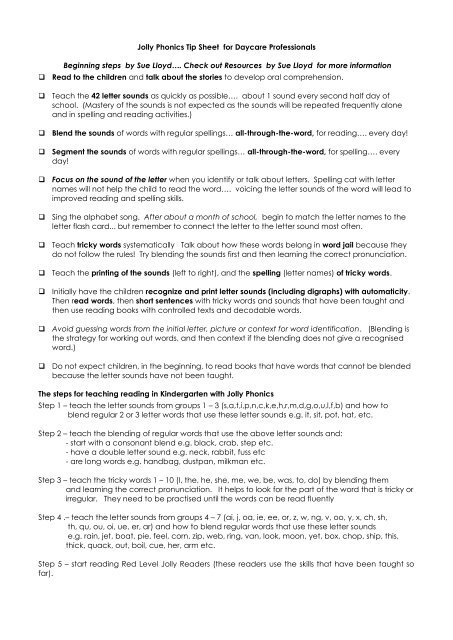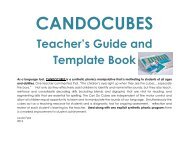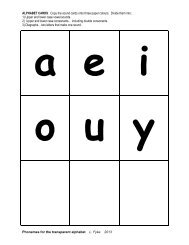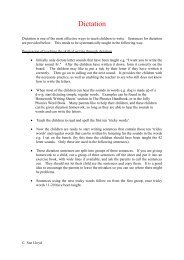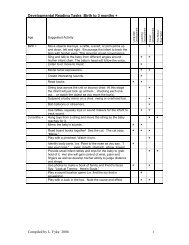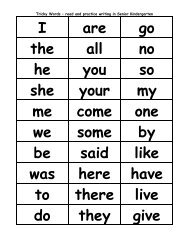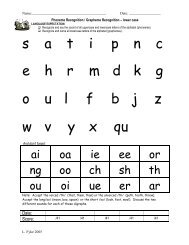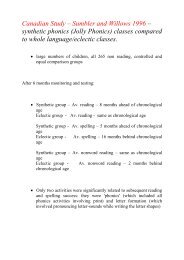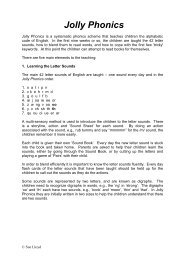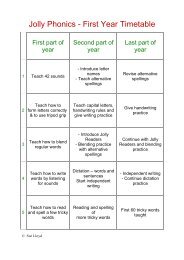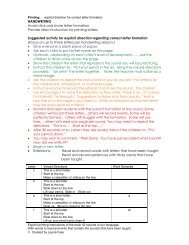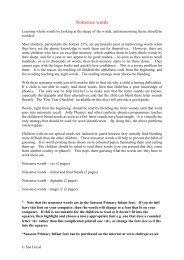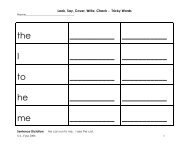Tip Sheet.pdf - Primarily Learning
Tip Sheet.pdf - Primarily Learning
Tip Sheet.pdf - Primarily Learning
Create successful ePaper yourself
Turn your PDF publications into a flip-book with our unique Google optimized e-Paper software.
Jolly Phonics <strong>Tip</strong> <strong>Sheet</strong> for Daycare Professionals<br />
Beginning steps by Sue Lloyd…. Check out Resources by Sue Lloyd for more information<br />
Read to the children and talk about the stories to develop oral comprehension.<br />
Teach the 42 letter sounds as quickly as possible…. about 1 sound every second half day of<br />
school. (Mastery of the sounds is not expected as the sounds will be repeated frequently alone<br />
and in spelling and reading activities.)<br />
Blend the sounds of words with regular spellings… all-through-the-word, for reading…. every day!<br />
Segment the sounds of words with regular spellings… all-through-the-word, for spelling…. every<br />
day!<br />
Focus on the sound of the letter when you identify or talk about letters. Spelling cat with letter<br />
names will not help the child to read the word…. voicing the letter sounds of the word will lead to<br />
improved reading and spelling skills.<br />
Sing the alphabet song. After about a month of school, begin to match the letter names to the<br />
letter flash card... but remember to connect the letter to the letter sound most often.<br />
Teach tricky words systematically Talk about how these words belong in word jail because they<br />
do not follow the rules! Try blending the sounds first and then learning the correct pronunciation.<br />
Teach the printing of the sounds (left to right), and the spelling (letter names) of tricky words.<br />
Initially have the children recognize and print letter sounds (including digraphs) with automaticity.<br />
Then read words, then short sentences with tricky words and sounds that have been taught and<br />
then use reading books with controlled texts and decodable words.<br />
Avoid guessing words from the initial letter, picture or context for word identification. (Blending is<br />
the strategy for working out words, and then context if the blending does not give a recognised<br />
word.)<br />
Do not expect children, in the beginning, to read books that have words that cannot be blended<br />
because the letter sounds have not been taught.<br />
The steps for teaching reading in Kindergarten with Jolly Phonics<br />
Step 1 – teach the letter sounds from groups 1 – 3 (s,a,t,i,p,n,c,k,e,h,r,m,d,g,o,u,l,f,b) and how to<br />
blend regular 2 or 3 letter words that use these letter sounds e.g. it, sit, pot, hat, etc.<br />
Step 2 – teach the blending of regular words that use the above letter sounds and:<br />
- start with a consonant blend e.g. black, crab, step etc.<br />
- have a double letter sound e.g. neck, rabbit, fuss etc<br />
- are long words e.g. handbag, dustpan, milkman etc.<br />
Step 3 – teach the tricky words 1 – 10 (I, the, he, she, me, we, be, was, to, do) by blending them<br />
and learning the correct pronunciation. It helps to look for the part of the word that is tricky or<br />
irregular. They need to be practised until the words can be read fluently<br />
Step 4 .– teach the letter sounds from groups 4 – 7 (ai, j, oa, ie, ee, or, z, w, ng, v, oo, y, x, ch, sh,<br />
th, qu, ou, oi, ue, er, ar) and how to blend regular words that use these letter sounds<br />
e.g. rain, jet, boat, pie, feel, corn, zip, web, ring, van, look, moon, yet, box, chop, ship, this,<br />
thick, quack, out, boil, cue, her, arm etc.<br />
Step 5 – start reading Red Level Jolly Readers (these readers use the skills that have been taught so<br />
far).
Step 6 – teach the 'y' sound when it is being a vowel and it takes on the vowel sound /ee/ (e.g.<br />
mummy, happy, funny, etc. ) or /ie/ (e.g. my, by, try, etc)<br />
Step 7 – teach the tricky words 11 – 20 (are, all, you, your, come, some, said, here, there, they).<br />
The steps for teaching writing in Kindergarten with Jolly Phonics<br />
Step 1 – teach the letter sounds from groups 1 – 3 (s,a,t,i,p,n,c,k,e,h,r,m,d,g,o,u,l,f,b), and how to<br />
write them. Regularly dictate a few letter sounds. This gives the children the necessary<br />
practice of writing the letters and enables you to check how many are known and if the<br />
formation is correct. Naturally very young children will not have the pencil control – just<br />
adapt expectations to the age of the children.<br />
Step 2 – call out simple words, such as hat, bus, red, fun, tin etc., and immediately say the sounds<br />
in each word, holding up a finger for each sound – hat ... h-a-t, bus ...b-u-s etc.<br />
Encourage the children to do it with you. Gradually the ability to hear the sounds<br />
develops until the children have the skill to say the sounds on their own.<br />
Step 3 – make words with magnetic plastic letters. Call out simple 2 or 3 letter words and<br />
ask your children to listen for the sounds and choose the correct letters for those<br />
sounds, placing them in a left to right order (either avoid using words with c or k in them<br />
or accept that the children might choose the wrong letter for the /k/ sound.)<br />
Alternatively you or a child could write the letters on the board or a white board as the<br />
sounds are called out.<br />
* letters on squares of paper can be used instead of plastic letters.<br />
Step 4 – dictate simple 2 or 3 letter words that use the letter sounds that are known by your<br />
children. Words can be found in the Jolly Phonics Word Book on Pages 3 – 8 (avoid<br />
words with double letters, such as hill, bell, puff etc.)<br />
Step 5 – practise listening for sounds in consonant blends – bl is b-l, sp is s-p, cr is c-r etc. Then<br />
ask your children to identify the sounds in words that have consonant blends in<br />
them, such as flat..f-l-a-t, stop..s-t-o -p etc. Words can be found in the Jolly<br />
Phonics Word Book on Pages 11 & 12. Then dictate words for your children to write or<br />
make with plastic letters.<br />
Step 6 – teach the letter sounds from groups 4 – 7 (ai, j, oa, ie, ee, or, z, w, ng, v, oo, y, x, ch, sh,<br />
th, qu, ou, oi, ue, er, ar) and how to write them. Dictate regular words that use these<br />
sounds, such as pain, jug, soap, tie, feed, sort, zigzag, went, sing, vet, boot, yes, fox,<br />
chin, shop, thin, queen, round, soil, value, arm. Words can be found in the Jolly<br />
Phonics Word Book – the first column of each page is very suitable for dictation.<br />
Step 7 – teach the tricky words 1 – 10 and how to spell them (take care that the children can<br />
read them before asking them to spell them). Use dictation to check that the spelling of<br />
these words is known.<br />
Step 8 – dictate sentences that contain tricky words 1 – 10 and regular words made from the letter<br />
sounds that have been taught so far, such as: He ran to the shops. I slept in a big bed.<br />
Step 9 – teach the tricky words 11 – 20 and dictate sentences that use these words and regular<br />
words made from the letter sounds that have been taught so far, such as:<br />
You are not to jump on your bed. Here are some sweets for you.<br />
*** Initially try to avoid asking the children to read or spell words that use letter sounds that have not<br />
been taught. Once there is confidence and fluency in the blending and reading of controlled words<br />
and texts then the children are much more able to cope with words that do not follow normal<br />
patterns. This system is successful because the teaching is systematic and builds up gradually.
*** Introduce new sounds and/or review sounds that have been taught as they are matched to the<br />
letter card or printed by the child … every day!<br />
*** Do blending and segmenting activities both orally and with printed text every day!


